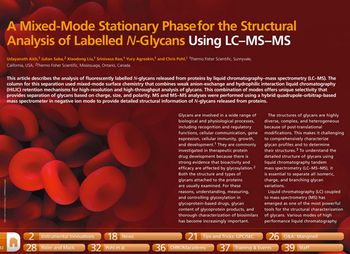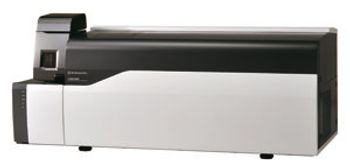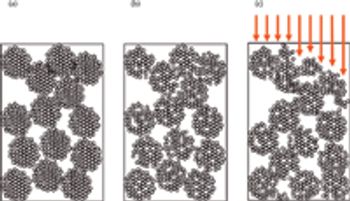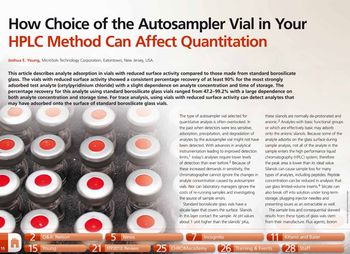
Click here to view the full European E-newsletter from December 12.

A selective review of companies who launched products in 2013.

The variance in the toxic effects of designer cannabis drugs marketed throughout Europe and the USA as "K2" or "Spice" could be the result of stereoselective metabolism of enantiomers by lung and liver enzymes, according to a study published in Analytical Chemistry.

Scientists at Sandia National Laboratories are thinking smaller in the development of detectors for military use - from the detection of explosives and chemical weapons to humans. Scientist Ron Manginell from the laboratories spoke to The Column about the on-going research in this area.

The ancient Egyptians embalmed meat mummies as an afterlife snack in the same way as their dead, according to the findings of a gas chromatography–mass spectrometry (GC–MS) analysis.

This article describes the analysis of fluorescently labelled N-glycans released from proteins by liquid chromatography–mass spectrometry (LC–MS).

Shoulders in gel permeation/size-exclusion chromatograms (GPC/SEC) can be a result of sample characteristics or down to the wrong choice of columns or column combinations. Proper selection helps to measure true results.

Staphylococcus aureus (S. aureus) evades clearance by the immune system by hijacking the very traps it produces, transforming these same traps into a toxic compound according to a paper published in Science.1 Scientists from the University of Chicago (Chicago, USA) used high performance liquid chromatography coupled to mass spectrometry (HPLC–MS) to identify the toxin as 2"-deoxyadenosine (dAdo).

Click here to view the full European E-newsletter from December 5.

Therapure Biopharma (Ontario, Canada) has entered into an agreement with Upfront Chromatography (Copenhagen, Denmark) to acquire assets and associated business related to human plasma fractionation from Upfront. As part of the deal Therapure will acquire proprietary protein purification technology based on expanded bed chromatography, along with exclusive rights to commercialize the technology.

Staphylococcus aureus (S. aureus) evades clearance by the immune system by hijacking the very traps it produces, transforming these same traps into a toxic compound according to a paper published in Science.1 Scientists from the University of Chicago (Chicago, USA) used high performance liquid chromatography coupled to mass spectrometry (HPLC?MS) to identify the toxin as 2?-deoxyadenosine (dAdo).

Shimadzu?s new LCMS-8050 triple quadrupole LC-MS/MS meets the growing demand for trace-level quantitation in clinical research and other markets. It incorporates proprietary ultrafast technologies as well as a newly developed ion source and collision cell technology.

In this instalment Ron Majors discusses new sample preparation media that could result in improved or even "breakaway" performance for solid–liquid extractions. Some of these sorbents are based on new novel bonded phases to existing media while others are based on new extraction phases, such as carbon on silica, other metal oxides, or polymeric media. With resulting new selectivities, sample preparation could be performed more quickly in fewer steps than typical of usual adsorbents

Why do some peaks front and others don't in the same method?

There are many "minor" variables in GC–MS analysis that can be optimized to improve selectivity or sensitivity. Knowing how to manually optimize the detector settings leads to better quality data.

Some solid–liquid extraction sorbents that have had significant development recently include MIPs, dSPE for QuEChERS, nanomaterials, and mixed-mode and silicone monolith sorbents.

A review of the 7th International Symposium on Packed Column SFC (SFC 2013), which was held in Boston, Massachusetts, from July 10 to 12, 2013.

Click the title above to open the LCGC Europe December 2013 regular issue, Vol 26 No 12, in an interactive PDF format.

Click the title above to open the LCGC North America December 2013 regular issue, Vol 31 No 12, in an interactive PDF format.

Click the title above to open the LCGC North America December 2013 Corporate Capabilities Supplement, Vol 31 No s12, in an interactive PDF format.

Agilent Technologies (California, USA) is to collaborate with the University of Queensland Centre for Clinical Research (Brisbane, Australia) to further understanding of the genomic differences governing oral cancer. According to the National Center for Biotechnology Information, oral cancer is the sixth most prevalent cancer worldwide.

Agilent Technologies (California, USA) is to collaborate with the University of Queensland Centre for Clinical Research (Brisbane, Australia) to further understanding of the genomic differences governing oral cancer. According to the National Center for Biotechnology Information, oral cancer is the sixth most prevalent cancer worldwide.

Click here to view the full European E-newsletter from 28 November.

PerkinElmer (Massachusetts, USA) has appointed Jon DiVincenzo as President, Environmental Health and Senior Vice President. DiVincenzo will take responsibility for the company?s environmental health business, which focuses on ensuring safer food and a cleaner environment.

Pumping Technologies

Kromasil UHPLC columns with 1.8 ?m spherical silica particles are the latest addition to the Classic Kromasil product line. With the highest efficiency, they will give you the best resolution with minimized turnaround time and laboratory costs.

LCGC North America Edit Calendar

The U.S. Pharmacopeial Convention (USP) (Maryland, USA) has announced that it will join the ?Fight the Fakes? campaign to raise awareness of counterfeit and substandard medicines.

This article describes analyte adsorption in vials with reduced surface activity compared to those made from standard borosilicate glass.

Scientists from San Pablo CEU University (Madrid, Spain) have developed a non-targeted global fingerprinting approach for lung tissue samples by performing three analytical methods ? liquid chromatography coupled to mass spectrometry (LC–MS), gas chromatography coupled to MS (GC?MS), and capillary electrophoresis coupled to MS (CE–MS). Published in the journal Analytical Chemistry, the study details the development and validation of the multi-platform approach using 20 mg of lung tissue.1